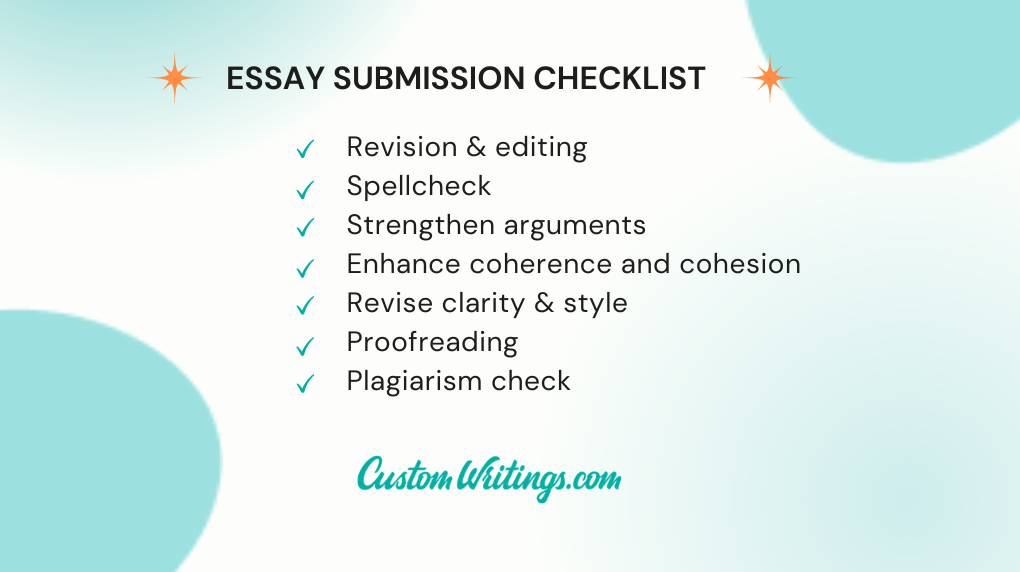Submitting a well-written and error-free essay is important for making a strong impression. This article provides a checklist of essential steps to help you create your draft essay. These steps increase your chances of achieving the best results for your essay submissions. Let’s delve into each stage and explore how it contributes to the excellence of your essay.
Step 1. Revise and Edit
Thorough revision and editing ensure a polished, error-free essay draft. It refines ideas, enhances clarity, and demonstrates your commitment to high-quality work. Don’t overlook this crucial step.
Tips for effective revision and editing:
- Multiple readings: Reviewing your essay many times is vital for effective revision. Focus on grammar and sentence structure to find errors and make necessary improvements.
- Removing unnecessary words and phrases: Concise, impactful writing engages readers. Edit your essay, eliminating unnecessary words, explanations, and repetitions. Focus on clarity and relevance over word count.
- Adhering to the assigned guidelines: If you’re looking to submit your essay, be sure to follow the submission guidelines and provide all the necessary information. Ensure that your essay follows the assigned format, referencing style, and word count. To ensure attention to detail, follow the guidelines, such as those of APA or MLA formatting.
Remember, while helpful, automated tools aren’t foolproof. Manual proofreading catches contextual errors. These tips will refine your essay’s structure, clarity, and credibility.
Step 2. Check Spelling
One crucial piece of advice for essay writers is to check the spelling in their work thoroughly. Proper spelling enhances the readability and professionalism of your essay. Here are some practical tips to help you ensure accurate spelling in your final essay submission:
- Use a Dictionary: When in doubt about the spelling of a particular word, consult a dictionary. It will provide you with the correct spelling and help you avoid errors.
- Spell-Check Feature: Most pieces of word processing software, such as Microsoft Word, Google Docs, and Pages, have built-in spell-check features. Utilize this tool to identify misspelled words and suggest corrections automatically.
- Grammarly: Grammarly is a widely used online writing assistant that checks grammar and helps with spelling. It flags misspelled words and offers suggestions for corrections.
- Hemingway Editor: Hemingway Editor is a helpful tool that checks spelling and evaluates the overall readability of your writing. It highlights spelling errors and suggests improvements for clarity and conciseness. Use it to correct your essay and enhance its impact.
By utilizing these tools and techniques, you can effectively check the spelling in your essay and ensure its accuracy. Remember that automated tools are helpful, but they are not foolproof. Manual proofreading and consulting reliable resources remain essential to catching any contextual errors or nuanced spelling issues.
Step 3. Strengthen Your Arguments
Strong arguments are essential for an engaging essay. They show critical thinking, analysis, and knowledge of the topic.
Strategies for strengthening your arguments:
- Reviewing and refining the thesis statement: The thesis statement is your essay’s central claim. Take the time to review and improve your paper for clear, specific language. It guides the reader through your content. Avoid using broad statements like, for example, “The impact of climate change on ecosystems is significant and needs to be addressed.” Instead, employ precise language to convey your point, such as “The rapid progression of climate change poses a critical threat to global ecosystems, demanding urgent action and comprehensive solutions.“
- Incorporating credible evidence from reliable sources: Use information from reliable sources, like articles and books, to support your arguments. Ensure relevance, contemporality, and proper citation for credibility and impactful ideas.
- Checking the logical flow and cohesiveness of the arguments: A well-structured essay flows with coherent connections between ideas and organized paragraphs. Review and refine your essay’s structure for a logical progression of arguments.
Additionally, address counterarguments to strengthen your position. Anticipating and refuting opposing viewpoints demonstrates critical thinking. Moreover, it reinforces the credibility of your arguments, making them more persuasive and logical. An argumentative essay checker can help you evaluate your opinions’ strengths and validity and identify areas for improvement.
Step 4. Enhance Coherence and Cohesion
Organizing your essay helps readers understand and follow your arguments. A logical structure enhances the information flow and creates a positive reading experience.
Techniques for enhancing coherence and cohesion:
- Using transitional words and phrases: Transitional words and phrases bridge sentences and paragraphs, improving the essay’s flow. Some examples of transitional words are “however,” “in addition,” and “therefore.” These words show connections, differences, and the progression of ideas in your essay.
- Ensuring clear topic sentences in paragraphs: Every paragraph should have a clear topic sentence introducing its central theme. This helps readers follow the essay better and makes the writing more cohesive. Be cautious about making broad statements such as “Technology has revolutionized the way we communicate and interact with others.” Instead, use particular phrases to make your argument, like, for example, “The rapid advancements in technology have fundamentally transformed the modes and dynamics of communication, revolutionizing our interactions with others.“
- Checking the essay’s overall structure: Review the structure for organization and coherence. Try to have a strong introduction with context and a thesis. Paragraphs should support specific points. The conclusion must summarize the main arguments and reinforce the thesis.
Consider using headings and subheadings for clarity in longer or more complex essays. These methods help you organize a cohesive structure and engage the readers.
Step 5. Reviewing Clarity and Style
Clarity, conciseness, and engaging writing are vital for a well-crafted essay. They ensure effective communication, cut wordiness, and captivate readers, enhancing the work’s quality.
Tips for improving clarity and style:
- Using clear and straightforward language: Avoid jargon and complex sentences that confuse readers like “The abstruse and intricate nature of the sociopolitical milieu necessitates the deployment of multifarious strategies to mitigate the ramifications and ameliorate the deleterious consequences.” Be clear, precise, and understandable. For example, try something like “The complex social and political landscape requires the implementation of various strategies to minimize the negative effects and improve the overall situation.” Maintain depth and complexity while conveying your ideas.
- Varying sentence lengths and structures: Vary sentence lengths and structures for a dynamic and engaging flow. Use short, impactful sentences: for example, “In modern scholarship, we must unravel the complexities of this multifaceted phenomenon.” Use long, complex ones for depth and elaboration: for example, “To advance our understanding of this phenomenon in the realm of contemporary scholarship, it is crucial to meticulously unravel and elucidate the intricacies inherent in its multifaceted nature.“.
- Reading the essay aloud: Reading your essay aloud helps identify clarity, flow, and phrasing issues. You can spot inconsistencies, errors, and unclear passages, ensuring effective communication.
Seek feedback from peers, instructors, or writing centers for valuable insights. Follow tips to improve the clarity and style of your writing. Use precise language, vary your sentences, and make your essay engaging to captivate your readers. If you are still unsure about sharing your paper, remember that some essay optional colleges allow applicants to decide whether they want to submit a paper as part of their application.
Step 6. Proofreading for Errors
Meticulous proofreading ensures an error-free final draft essay, showcasing your attention to detail. Careless mistakes can overshadow even well-crafted arguments, diminishing the quality and level of professionalism. Present high-quality polished work by dedicating time to proofreading. This shows your commitment to producing excellent content.
Strategies for effective proofreading:
- Careful review of each sentence: Review each sentence for grammar and punctuation errors. Also, it is important to check agreement between different parts of speech, tense consistency, and proper punctuation. Careful reading helps identify overlooked grammatical and structural issues in your essay.
- Correcting common mistakes: Check for spelling, word usage, and punctuation errors. Use spell-check, but also review for contextual mistakes. Verify references and citations for proper formatting.
- Taking breaks: When proofreading, take breaks to refresh your perspective. Taking pauses might assist you in identifying errors and improving your proofreading skills.
Approach proofreading with a critical eye and a meticulous mindset. These strategies can improve your essay’s clarity, correctness, and professionalism. Remember to keep a record of the papers you have submitted, including the dates, titles, and publication details.
Leticia Adamson, Head of ESL program at CustomWritings.com
Step 7. Check for Plagiarism
Maintaining originality in your essay is crucial. Plagiarism undermines integrity and credibility. Uniqueness respects others’ work, follows ethical rules, and helps the academic community.
Steps to ensure authenticity and avoid plagiarism:
- Utilize plagiarism detection tools: Turnitin, Copyscape or Plagiarism Check by CustomWritings check your essay for plagiarism by comparing it to others.
- Properly cite and reference sources: Cite and reference sources to give credit and avoid plagiarism. Follow the required citation style and include a comprehensive bibliography or reference list.
You show a commitment to academic honesty and integrity by incorporating these steps. An essay paper checker is important to ensuring your results. It will also allow you to engage with existing research. Moreover, it is necessary to contribute to academic discussions.
Step 8. Seeking Feedback
Seeking feedback from others is valuable. It helps to gain fresh perspectives, identify flaws, and improve your essay. It provides insights into clarity, coherence, and impact. Options for constructive feedback include:
- Asking trusted individuals for reviews and suggestions: Seek feedback from friends, classmates, or family members with writing skills. Request specific recommendations to enhance arguments, improve clarity, or address weaknesses.
- Utilizing online writing communities and workshops: Share your work in online communities and writing seminars. Engage in discussions, receive critiques, and exchange ideas with fellow writers.
- Consulting writing center services or instructors: Take advantage of writing center services in educational institutions. Meet with writing tutors to get helpful advice on making your writing better. Consult instructors or professors during office hours.
Feedback from various sources provides diverse perspectives and helps identify strengths and weaknesses. Try to approach input with an open mind for growth and refinement. For example, submitting personal essays offer a unique opportunity to share your experiences and perspectives with readers. Using feedback helps to fix your work’s problems and to show its strengths. If you want to share your writing with a broader audience, find places to submit essays.
A comprehensive essay checklist is essential to ensuring a well-crafted and error-free essay. You can improve the quality by completing each step on the list.
Remember that your effort in your essay shows your dedication and professionalism. Embrace the checklist, work hard, and submit a paper you can feel proud of. Publishing an essay can be a fulfilling experience, as it allows you to share your work with a wider audience.
Secret Tip: Making Your Essay Longer
Don’t focus on making your paper longer. Instead, focus on quality and relevance. To submit an essay, focus on providing concise arguments over unnecessary information. Remember, the quality and depth of your content matter, not the word count. When making an essay longer, focus on expanding your ideas, providing additional examples, and including relevant supporting evidence.




